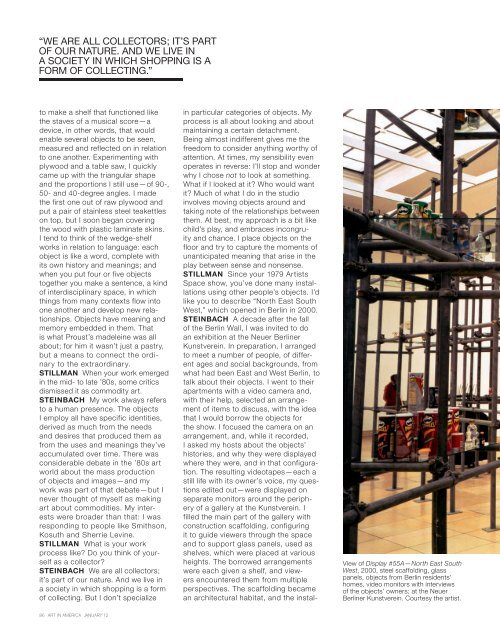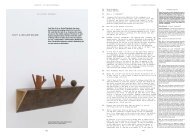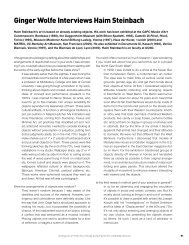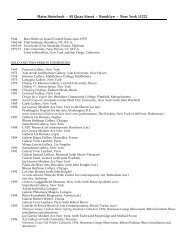Haim Steinbach in the Studio with Steel Stillman
Haim Steinbach in the Studio with Steel Stillman
Haim Steinbach in the Studio with Steel Stillman
You also want an ePaper? Increase the reach of your titles
YUMPU automatically turns print PDFs into web optimized ePapers that Google loves.
“WE ARE ALL COLLECTORS; IT’S PART<br />
OF OUR NATURE. AND WE LIVE IN<br />
A SOCIETY IN WHICH SHOPPING IS A<br />
FORM OF COLLECTING.”<br />
to make a shelf that functioned like<br />
<strong>the</strong> staves of a musical score—a<br />
device, <strong>in</strong> o<strong>the</strong>r words, that would<br />
enable several objects to be seen,<br />
measured and reflected on <strong>in</strong> relation<br />
to one ano<strong>the</strong>r. Experiment<strong>in</strong>g <strong>with</strong><br />
plywood and a table saw, I quickly<br />
came up <strong>with</strong> <strong>the</strong> triangular shape<br />
and <strong>the</strong> proportions I still use—of 90-,<br />
50- and 40-degree angles. I made<br />
<strong>the</strong> first one out of raw plywood and<br />
put a pair of sta<strong>in</strong>less steel teakettles<br />
on top, but I soon began cover<strong>in</strong>g<br />
<strong>the</strong> wood <strong>with</strong> plastic lam<strong>in</strong>ate sk<strong>in</strong>s.<br />
I tend to th<strong>in</strong>k of <strong>the</strong> wedge-shelf<br />
works <strong>in</strong> relation to language: each<br />
object is like a word, complete <strong>with</strong><br />
its own history and mean<strong>in</strong>gs; and<br />
when you put four or five objects<br />
toge<strong>the</strong>r you make a sentence, a k<strong>in</strong>d<br />
of <strong>in</strong>terdiscipl<strong>in</strong>ary space, <strong>in</strong> which<br />
th<strong>in</strong>gs from many contexts flow <strong>in</strong>to<br />
one ano<strong>the</strong>r and develop new relationships.<br />
Objects have mean<strong>in</strong>g and<br />
memory embedded <strong>in</strong> <strong>the</strong>m. That<br />
is what Proust’s madele<strong>in</strong>e was all<br />
about; for him it wasn’t just a pastry,<br />
but a means to connect <strong>the</strong> ord<strong>in</strong>ary<br />
to <strong>the</strong> extraord<strong>in</strong>ary.<br />
STILLMAN When your work emerged<br />
<strong>in</strong> <strong>the</strong> mid- to late ’80s, some critics<br />
dismissed it as commodity art.<br />
STEINBACH My work always refers<br />
to a human presence. The objects<br />
I employ all have specific identities,<br />
derived as much from <strong>the</strong> needs<br />
and desires that produced <strong>the</strong>m as<br />
from <strong>the</strong> uses and mean<strong>in</strong>gs <strong>the</strong>y’ve<br />
accumulated over time. There was<br />
considerable debate <strong>in</strong> <strong>the</strong> ’80s art<br />
world about <strong>the</strong> mass production<br />
of objects and images—and my<br />
work was part of that debate—but I<br />
never thought of myself as mak<strong>in</strong>g<br />
art about commodities. My <strong>in</strong>terests<br />
were broader than that: I was<br />
respond<strong>in</strong>g to people like Smithson,<br />
Kosuth and Sherrie Lev<strong>in</strong>e.<br />
STILLMAN What is your work<br />
process like? Do you th<strong>in</strong>k of yourself<br />
as a collector?<br />
STEINBACH We are all collectors;<br />
it’s part of our nature. And we live <strong>in</strong><br />
a society <strong>in</strong> which shopp<strong>in</strong>g is a form<br />
of collect<strong>in</strong>g. But I don’t specialize<br />
86 ART IN AMERICA JANUARY’12<br />
<strong>in</strong> particular categories of objects. My<br />
process is all about look<strong>in</strong>g and about<br />
ma<strong>in</strong>ta<strong>in</strong><strong>in</strong>g a certa<strong>in</strong> detachment.<br />
Be<strong>in</strong>g almost <strong>in</strong>different gives me <strong>the</strong><br />
freedom to consider anyth<strong>in</strong>g worthy of<br />
attention. At times, my sensibility even<br />
operates <strong>in</strong> reverse: I’ll stop and wonder<br />
why I chose not to look at someth<strong>in</strong>g.<br />
What if I looked at it? Who would want<br />
it? Much of what I do <strong>in</strong> <strong>the</strong> studio<br />
<strong>in</strong>volves mov<strong>in</strong>g objects around and<br />
tak<strong>in</strong>g note of <strong>the</strong> relationships between<br />
<strong>the</strong>m. At best, my approach is a bit like<br />
child’s play, and embraces <strong>in</strong>congruity<br />
and chance. I place objects on <strong>the</strong><br />
floor and try to capture <strong>the</strong> moments of<br />
unanticipated mean<strong>in</strong>g that arise <strong>in</strong> <strong>the</strong><br />
play between sense and nonsense.<br />
STILLMAN S<strong>in</strong>ce your 1979 Artists<br />
Space show, you’ve done many <strong>in</strong>stallations<br />
us<strong>in</strong>g o<strong>the</strong>r people’s objects. I’d<br />
like you to describe “North East South<br />
West,” which opened <strong>in</strong> Berl<strong>in</strong> <strong>in</strong> 2000.<br />
STEINBACH A decade after <strong>the</strong> fall<br />
of <strong>the</strong> Berl<strong>in</strong> Wall, I was <strong>in</strong>vited to do<br />
an exhibition at <strong>the</strong> Neuer Berl<strong>in</strong>er<br />
Kunstvere<strong>in</strong>. In preparation, I arranged<br />
to meet a number of people, of different<br />
ages and social backgrounds, from<br />
what had been East and West Berl<strong>in</strong>, to<br />
talk about <strong>the</strong>ir objects. I went to <strong>the</strong>ir<br />
apartments <strong>with</strong> a video camera and,<br />
<strong>with</strong> <strong>the</strong>ir help, selected an arrangement<br />
of items to discuss, <strong>with</strong> <strong>the</strong> idea<br />
that I would borrow <strong>the</strong> objects for<br />
<strong>the</strong> show. I focused <strong>the</strong> camera on an<br />
arrangement, and, while it recorded,<br />
I asked my hosts about <strong>the</strong> objects’<br />
histories, and why <strong>the</strong>y were displayed<br />
where <strong>the</strong>y were, and <strong>in</strong> that configuration.<br />
The result<strong>in</strong>g videotapes—each a<br />
still life <strong>with</strong> its owner’s voice, my questions<br />
edited out—were displayed on<br />
separate monitors around <strong>the</strong> periphery<br />
of a gallery at <strong>the</strong> Kunstvere<strong>in</strong>. I<br />
filled <strong>the</strong> ma<strong>in</strong> part of <strong>the</strong> gallery <strong>with</strong><br />
construction scaffold<strong>in</strong>g, configur<strong>in</strong>g<br />
it to guide viewers through <strong>the</strong> space<br />
and to support glass panels, used as<br />
shelves, which were placed at various<br />
heights. The borrowed arrangements<br />
were each given a shelf, and viewers<br />
encountered <strong>the</strong>m from multiple<br />
perspectives. The scaffold<strong>in</strong>g became<br />
an architectural habitat, and <strong>the</strong> <strong>in</strong>stal-<br />
View of Display #55A—North East South<br />
West, 2000, steel scaffold<strong>in</strong>g, glass<br />
panels, objects from Berl<strong>in</strong> residents’<br />
homes, video monitors <strong>with</strong> <strong>in</strong>terviews<br />
of <strong>the</strong> objects’ owners; at <strong>the</strong> Neuer<br />
Berl<strong>in</strong>er Kunstvere<strong>in</strong>. Courtesy <strong>the</strong> artist.





